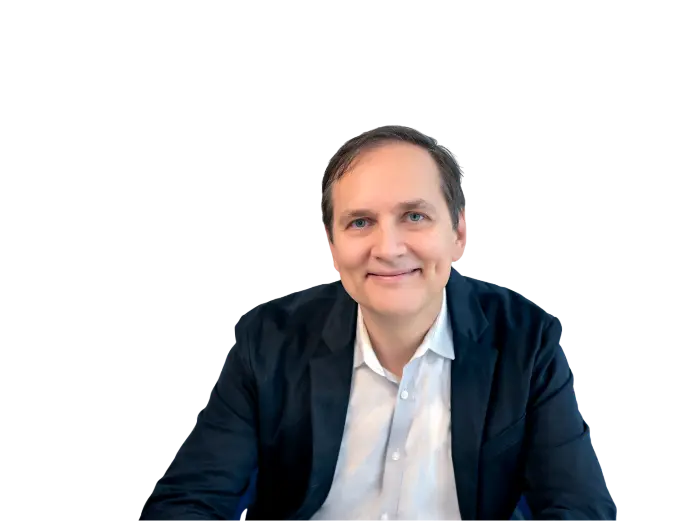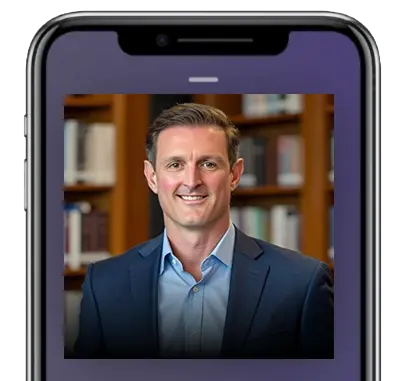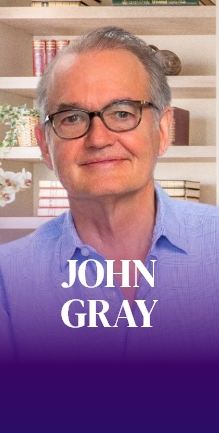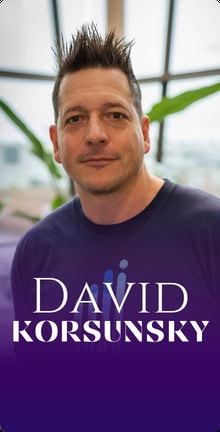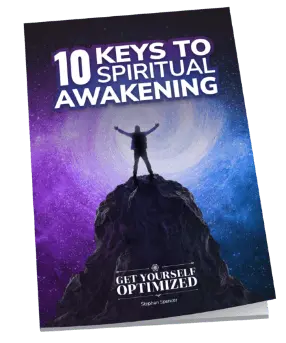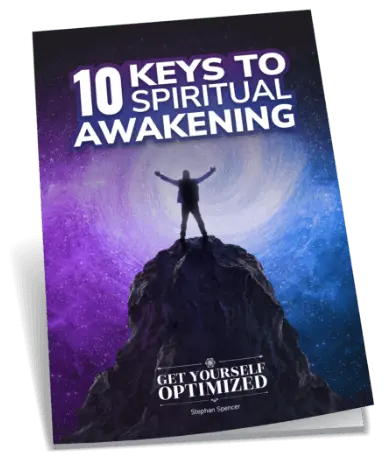In this Episode
- [02:35]Chas Gessner talks about Vitality Rx, which focuses on integrative hormone health for men, leveraging telemedicine.
- [07:31]Chas differentiates between total testosterone and free testosterone, emphasizing the importance of free testosterone.
- [10:18]Chas differentiates between total testosterone and free testosterone, emphasizing the importance of free testosterone.
- [17:43]Chas addresses high estrogen levels, explaining the impact of body fat and phytoestrogens.
- [21:51]Chas introduces the concept of peptides and their role in biohacking, emphasizing the importance of a strong foundation of health before using peptides.
- [30:31]Chas emphasizes the importance of getting sunlight in the eyes upon waking and maintaining a consistent wake-up time.
- [46:24]Chas discusses the importance of emotional regulation and stress management for overall health.
Chas, it’s so great to have you on the show.
Likewise, thanks for having me. Really appreciate it.
We know each other from a mastermind. We could talk about that; we’ve known each other for over a decade now.
Yeah, wow. Time flies when you’re having fun. 10 years.
Why don’t we start with your superhero story, your hero’s journey? You had a pretty illustrious past and a very exciting future ahead of you. Why don’t you take us on that journey?
I took a fairly non-traditional path out of the Ivy League and bounced around in the NFL for about seven or eight years. That was a journey in and of itself. Learned a lot of lessons, learned not to have too many highs or lows and roll with the punches. I was always a fringe guy. I was always bouncing back and forth between the practice squad and the active roster. I would get injured, and I would get cut, and I would go somewhere else, a lot of bouncing around, and I lived in a lot of different places.
After I got done with football, I got into the healthcare sector, worked for a couple of big industry titans, like Stryker and Olympus, doing medical sales, got a front row seat from the executive C-suite of hospitals to operating rooms, to private practices. Right around that time, I was going through a lot of the health issues that men tend to go through later in life, maybe later in their forties. I was in my late twenties and early thirties, going through a lot of stuff.
When there’s a lot of chaos around you, the one thing you can control is your habits. Share on XThe biggest probable reason was a lot of wear and tear on the body, a lot of head trauma, things like that. They just come with hard charging for a really long time, and all the stress that comes with it. Then, all the physical components of it. With my background in performance optimization, I started searching for answers outside the traditional healthcare system, not just for something that’s broken. Let’s put a Band-Aid on it. It’s more digging into what’s at the root of the issue. Started doing a bunch of different labs, reconnected with an old friend of mine from Brown, actually, who had become a naturopathic doctor. And once we popped the hood and really looked at what was going on, there was a lot of stuff awry. I set about finding the best way to fix a lot of those issues. And that was where my current company, Vitality Rx, was born.
How long has Vitality Rx been around?
It’s been about seven years, maybe coming up to eight. We’ve gone through a couple of different iterations. The first iteration of the company was a concierge medical clinic. We built a network of nurse practitioners in Southern California. So, LA, OC, San Diego: to-do in-home exams, blood draws, IVs, and a lot of that kind of stuff, concierge-style. And then COVID hit. That made things fairly interesting in terms of the at-home component. And as diagnostics and telemedicine have evolved, we’ve slowly moved to a fully virtual platform and pivoted to our current iteration: integrative hormone health for men via telemedicine.

COVID was a big disruption for your business, ultimately a blessing in disguise, as you were able to pivot to a virtual model that is more scalable for you.
People started to become a lot more accepting of that model right around that time. It was already on the rise, but it really exploded. And then, even in terms of regulations and things like that, it opened a lot of things up in terms of accessibility.
What are some of the tests and the dials that you wanna turn to optimize your performance and your health, especially for men, as we have societally been seeing dropping testosterone levels in men and so forth? There’s a lot of stuff out there that we’re getting subjected to, endocrine disruptors, microplastics, all sorts of nasty stuff, and it just seems to be getting worse and worse.
It really is. The anecdote is that a 45-year-old man today has the same testosterone levels as their dad did when he was 65—a precipitous drop over the last 50 years or so. You’ve got all the trappings of modern life, all the stress, poor sleep, the nutrient depletion in the food, and the hormones and chemicals in the food. As you said, all the different endocrine disruptors and personal care products. The list goes on and on. We’re under constant bombardment there.
A 45-year-old man today has the same testosterone levels as their dad did when he was 65—a precipitous drop over the last 50 years or so.
Hormones are really the foundation of health and longevity for everyone. It’s often overlooked because testosterone gets thrown around a lot, and there’s a negative connotation sometimes with testosterone or maybe just a misunderstanding of its function. In men, it’s the master regulator of the endocrine system. By no means is it the only important hormone, but it is very important. But when it comes to testing, what’s often overlooked is the interplay.
What’s often overlooked is the interplay between testosterone and estrogen, for instance, or another hormone called luteinizing hormone, which in effect is the signal from your brain to the testes that says, ‘Produce testosterone and sperm.’ There’s sex hormone binding globulin, which binds to testosterone and then determines how much circulating testosterone or free testosterone you have in your body. That’s often overlooked and misunderstood. Those are some key biomarkers that are really important to focus on and at least check in on from time to time.
One of my past guests is actually my doctor, Dr. Hotchner. He’s phenomenal, based here in Miami, where I’m currently shooting this video. One of the things that he explained is that the normal range, as determined by whoever on the lab reports, is nonsense. It’s really lousy. If you consider yourself in that normal range, you could be really off the mark in terms of what would be considered healthy.
It’s fairly meaningless. Unfortunately, there are a lot of docs and clinics that don’t understand that and just go off the ranges. The acceptable range is for all age groups; any guy in the 25-80 age range falls within 280-1200, or something like that. If you’re off the range on the bottom or the top, that’s when they say, “Okay. Do an intervention, but if you’re anywhere inside that range, you’re fine?” And that’s also, that’s just total testosterone. It’s not even the most important marker of testosterone, which is free testosterone. It doesn’t take into account people’s individual biochemistry or the other hormones at play, either.
Explain to our listener the difference between total testosterone and free testosterone.
In men, the hormone is the master regulator of the endocrine system.
Total testosterone is important because it’s the amount of testosterone your body produces. Free testosterone is the amount that’s not bound by sex hormone-binding globulin and albumin in the body. So it’s actually your free circulating testosterone that can be used. That’s a pretty important distinction. The range of total testosterone is 280 to 1200. Free testosterone. I don’t know what the typical acceptable range is. We find that guys start having symptoms when it’s anywhere below around 12 nanograms per deciliter.
What are some of the typical symptoms that you might, whoever the listener is, if it’s a guy, would be experiencing?
A lot of guys tend to think it has, but it only has something to do with sexual function, which is a part of it. But the bigger symptoms are energy, mood, emotional regulation, focus, weight gain, all the things that you would kind of typically say if your buddy asked you how you’re feeling and you just said, “Man, I feel like I’m getting older.” All the things that you would associate with those are the symptoms of hormone dysfunction.
That’s boiled frog syndrome, where the frog doesn’t realize that the water is getting hotter until it’s too late. How do you get on top of this in a way that is more proactive than just waiting for that water to finally boil?
Women have menopause. That hits them, and it’s fairly sudden. They have had perimenopause prior, and there’s a transition period. But with men, it’s something that slowly happens just naturally, without all the things we mentioned that are working against you, just naturally, your testosterone falls by about two to 3 % a year. If you actually do the math on that every decade, that’s a 10 to 15% decrease in testosterone from 40 to 50 or from 30 to 40. So, from 30 to 50, that’s a 20-30% decline in testosterone. And that’s all of those other confounding variables taken out of the equation.
Total testosterone is important because it’s the amount of testosterone your body produces. Free testosterone is the amount that’s not bound by sex hormone-binding globulin and albumin in the body.
It does happen fairly slowly, and it affects people differently. The culture, the kind of hustle culture, rewards, grittiness and just kind of you’re suffering in silence, almost for men. And so it does happen fairly slowly, and it goes unchecked. So really, it’s just a matter of, we said the ranges are so big, everybody’s so different. What you’re checking for are trends over time. With that said, it’s always important to get at least a baseline of where you’re at, a snapshot in time you can compare yourself to later.
All right, so that entails a blood test.
That entails a test, which you can get at a lab, a core request, or a doctor. You have to be careful about them giving you a complete panel. And then being knowledgeable about the nuances of hormones. We use an at-home test kit. There’s been some really cool advances in remote diagnostics and small blood volume collection. There’s a device we use that looks like this; it’s called a Tasso device. And you stick this on your shoulder, click this button, and it pokes a little hole in the skin, then a little bit of capillary blood drips into this tube. You peel it off your shoulder, put it in the box, and then it’s sent to our lab for processing. From that, we can actually get a full panel of the labs I was talking about.
All right, cool. How much is your test kit, and are you offering our listeners and viewers a discount?
The test kit and telemedicine consult. You’ll use the test kit, send it in, get the labs, and then, included in that, you’ll hop on a telemed consult with an actual men’s health expert to discuss your results and chart a path forward. That’s typically $149. So we’ll offer a $20 off coupon code: GYO20, to your audience. They can just go to the website vitalityrx.com, click ‘get started’, and it’ll take them through the process.
Awesome, well, thank you, that’s generous of you. I love this supposedly Peter Drucker quote, but I think it was misattributed. It’s “What gets measured gets managed.” I’m sure our listeners who have listened for a while have heard me say that quote before, but in the case of health and in this specific instance of men’s health, I think this is critically important because if you’re not measuring, you don’t know if you’re making any real improvements by making lifestyle changes or taking various supplements and so forth. And a lot of supplements have extra junk in them that you don’t really want. Tell us more about how to educate our listeners on this.

I love that you said that. I use that saying all the time, too, because people not only look for a silver bullet but also spray the board. And it’s just not a very good way to figure out, not only if something’s working, because the likelihood that you’re only doing one thing different is very low. There are just too many other variables. But how do you know if you ever needed it in the first place? And so you can apply that principle to most things. We talk about that a lot. That’s why we have that diagnostic component. And that’s very important. As far as supplements, it’s trickier.
There are only a couple of accurate ways to test certain micronutrients. I think we kind of operate on the assumption that, based on the standard American diet, most Americans are deficient in things like vitamin D, things like omegas, stuff like zinc, magnesium, these really kind of important foundational vitamins and minerals and antioxidants that can only help. They can’t hurt. And you mentioned the other issue, though, is purity and potency. We’ve got these proprietary blends that are out there. You don’t know exactly what’s in it or how much of each thing.
There are things like the AG1, with 15,000 different ingredients, and you don’t know how much of each one there is. And it’s likely just a little dusting of each, not enough to make an impact. You can make the argument that it’s better than nothing. But with our supplementation, we like to be on the top end of the range in terms of purity and therapeutic potency. That’s really important. And there aren’t many brands out there that meet that standard.
Did you formulate your own blends and sell those on your site?
Zinc is one of those things where we’re not dosing it high enough, so if you have fairly normal or high zinc levels, 20 milligrams of zinc a day is gonna make too much of a difference.
We have a daily vitamin pack. I have mine each day. This comes in a 30-pack. There’s a box that’s a roll, and I tear off my vitamins for the day. We stay away from blends, but this pack we’ll have ADEK, Boron, CoQ10, B complex, NR (a precursor to glutathione), omega-3, and zinc. And so these are all single-ingredient, high-purity, high-potency vitamins. They’re already separated into daily packs for you, which is very different from opening all those other bottles of vitamins or meal-prepping them yourself. It makes it easier to stay consistent, to travel with them, all that kind of stuff. That’s always part of our program. Even the hormone reboot program. That’s an important component of it that’s often overlooked. But we do have some packs for specific use cases that we sell separately.
If I have really high zinc levels, I’m likely not getting zinc supplementation in my packet.
We don’t have a diagnostic test for micronutrients yet. We will eventually be. Zinc is one of those things where we’re not dosing it high enough, so if you have fairly normal or high zinc levels, 20 milligrams of zinc a day is gonna make too much of a difference. There’s a very, very high likelihood that nobody really has too high levels of any of these foundational vitamins and minerals.
Gotcha. And so you said this is part of a program. What are the other components? What are the components of getting your hormone levels up to optimal?
We have a prescription component in our program, which is why we call it an integrative approach. Kind of, it’s a combination of holistic and conventional medicine. The prescription component: we’ve compounded a capsule containing N-Clomophene, a prescription compound that essentially stimulates the brain to produce more luteinizing hormone, which signals the testes to produce testosterone. So that’s the main foundational backbone of the compound, which is in clomophene. We do it a little differently from most other practitioners, but I can get into that later.
When you're low energy, you're more temperamental, less patient, less kind, and less emotionally regulated. Energy is the key to many of the problems in our lives. Share on XWe put DHEA in the compound. DHEA is a building block for hormones. Seven keto DHEA is another way to get a little more DHEA into the system, but it’s not endogenous. And then a very low dose of progesterone helps balance testosterone and estrogen, improving sleep quality. So those are the main ingredients. So even that compound, right, we’re combining some prescriptions with some over-the-counter supplements to create a really integrative compound that, with a lot of those things, work very well together synergistically.
What happens if somebody has, if a guy has high estrogen levels from, let’s say, eating a lot of soy products? How do you address that? Is that part of the program, too?
See it a lot actually, not necessarily high, sometimes high, sometimes low. Estrogens, we call it a Goldilocks hormone. There’s a sweet spot there. You don’t want it too high, you don’t want it too low. And interestingly enough, if it’s too high or too low, you start getting a lot of the same symptoms as low testosterone. Typically, it’s accompanied by either too high testosterone or too low testosterone. One thing you can do is if someone has really high estrogen, normally, and low testosterone, it typically means that their body is aromatizing, which means converting too much testosterone into estrogen. That’s typically an issue of too much body fat. Body fat is where the body aromatizes testosterone and estrogen.
Some of these phytoestrogens have been overblown in terms of their impact, but it’s definitely a factor, and it’s only made worse by being overweight. You can address that by raising testosterone levels, losing body weight, and improving metabolic function. If it gets too high and symptomatic for too long, you can use a very small amount of an aromatase inhibitor, an estrogen blocker. We try to avoid that as much as possible. Estrogen is good. You definitely don’t want to over-suppress it, and you definitely don’t want to suppress it if you don’t have to.
When someone has what’s called primary hypogonadism, that means the brain’s sending the signal to the testes, but the testes just aren’t working.
Let’s go deeper into what the different modalities are that are typical for somebody with low testosterone. They get prescribed testosterone from a compounding pharmacy, or they get shots of testosterone, the replacement therapy. Are the different modalities that they’re going to get recommended by a traditional allopathic doctor? And what is your caution for those folks who get that kind of advice?
The traditional treatment for low testosterone is just kind of a blanket policy; if someone has clinically low testosterone, we just prescribe them testosterone. That’s when you hear TRT or HRT, that’s testosterone replacement therapy or hormone replacement therapy. That’s essentially you’re low in testosterone. Let’s give you testosterone. That can be useful in certain circumstances, but it’s greatly overprescribed and sometimes mismanaged.
When someone has what’s called primary hypogonadism, that means the brain’s sending the signal to the testes, but the testes just aren’t working. They’re not producing the testosterone. That’s when TRT makes sense, because the testes aren’t gonna produce it no matter what you do. That’s 10 % or less of the cases of hypogonadism; much more likely is secondary or functional hypogonadism, which means the brain just isn’t sending enough of the signal to the testes to produce testosterone. And that’s where our solution makes a lot more sense.
Stimulating the luteinizing hormone, was it?
Luteinizing hormone, stimulating LH, then signals the testes to produce more testosterone, and then you’re working with your body’s own natural mechanism, stimulating a more natural process, essentially.
That’s more sustainable, easier on the body.
Because it’s almost like the concept of a peptide, you’re stimulating a response or reaction in the body instead of just giving something to someone who’s lacking.
Let’s talk a little bit about peptides, because you hear about them in biohacking circles and so forth, but I don’t think it adequately explains why this is a thing now and what the benefits are—like, what did we do before peptides were available on Amazon? I don’t know.
I’m by no means a peptide expert, but I do have a basic understanding. Peptides are chains of amino acids. Your body has thousands and thousands of peptides circulating at any given time, and they all carry out different functions. Some proteins carry out different functions.
Like for signaling.
If you’re using peptides without addressing some of the foundational components of health, it’s like you’re building a house on sand.
For signaling, exactly. A really popular one is ipamorelin or ipamorelin plus CJC. That’s a growth hormone secretagogue. That helps signal the production of more growth hormone pulses. There are things like that. Like you said, there’s plenty of evidence if you look for it. You can make arguments about how strong it is. My take on peptides is that many people treat them like a silver bullet, using them as a band-aid. And most of us are walking around at a three or four out of 10. And there are a lot more things you need to do to build a strong foundation, getting you to a 7 or 8 out of 10, before peptides can get you that last little bit of improvement. And if you’re using peptides, without addressing some of those foundational components of health, it’s like you’re building a house on sand.
Some of these can be dangerous or ill-advised. We ordered, for example, BPC 157, and I don’t know if we even finished the bottle. I read something, or I watched a video. This is a little bit dangerous, you don’t wanna just be trying to be your own doctor on this stuff.
Exactly. Think that’s unfortunate, and that gives it. They say, “This is why we can’t have nice things.” These are incredibly powerful compounds that, when used properly under the right supervision by somebody who really understands the complex nuances, can be super effective. But unfortunately, we’re all DIY and this stuff, and anything you can buy on the internet is essentially illegal. They’re selling it for research purposes only, so if you’re using that for yourself, it’s not regulated.
You don’t know, there are now some sites and platforms that are coming out that are doing third-party testing on some of the major manufacturers. I think that’s getting better, but unless you have a practitioner guiding you through that stuff, and unless you’ve done everything you need to do to get yourself to an 8 out of 10, I just think there are a lot more important things you can focus on.
Like sleep hygiene and things like that are just so basic, and overlooked or under-focused.
100% sleeps, sleeps right up there. It’s gotta be in your top three or four. People just don’t realize that they’ve measured the impact of sleep on hormones, health, cardiovascular health, and mortality, among other things. We can unequivocally show the impact of high-quality, high-quantity sleep, which is far more impactful than a peptide that advertises it can improve sleep or whatever. But those are boring and they’re unsexy, that thing. I’ve gotten into sleep optimization. I’m really close to buying the Eight Sleep mattress. I’ve heard really good things about it. There’s something in the back of my head saying, Do I want to be sleeping in a wifi signal?

And you can’t sell them for $150 a bottle.
Though bathing, bathing in the Wi Fi signal from the mattress. I don’t know what I haven’t. I haven’t dug deep enough to know if that’s actually an issue or a thing, or if you can turn it off or put a Faraday cage or something on it. But that’s the only thing that I haven’t done to optimize sleep yet.
A mattress that is on the Wi-Fi network?
It’s called the Eight Sleep Mattress. You can unplug it because it has all these diagnostics built in, and it adjusts to your body temperature at night and keeps you at a perfect temperature, which is a great concept. But it operates via Wi-Fi and Bluetooth, which I don’t know —maybe not, maybe not.
If you can put it on airplane mode, which is ironic, you’d never put it in. You’d never take your mattress on an airplane. But like the Oura Ring, I’m wearing mine right now. You can have it in airplane mode, and then it’s not using Bluetooth to stay connected to your phone all day long. If you don’t get notifications if you’ve been sitting too long, but you also don’t get doused with radiation all day long.
You can upload the data once a day, or whatever works for you. I use the whoop. I do the same thing sometimes, too. But it’s good to think we talked about diagnostics. Not sure how accurate it is, but as long as it’s inaccurate by the same amount all the time, I can use that to track trends and changes over time, and I can play around with stuff and kind of loosely associate, “Okay, I did that thing and that created that sort of impact. What gets measured gets managed. It’s valuable, valuable data.”
What are you paying attention to as far as the metrics on your Whoop, and what sort of actions are you taking to make improvements to those numbers?
Well, everything on the Whoop is built around HRV. I’m constantly trying to improve that metric. But there are.
Now, many of our listeners will be familiar with HRV, but for those who are not, we want to explain it.
Heart rate variability they found to be a great predictor of overall health. It’s measuring the resilience of your heart. Like how quickly you can go from parasympathetic to sympathetic and back and forth. That’s a fairly good way to measure overall health and longevity.
If you don’t have much variability, if it’s really bad, then you’re near death, basically.
That’s not as good. Which means your body isn’t able to respond the way it needs to to keep you safe and functioning properly. So the more variability, the better, so you can push yourself, adapt, respond, recover properly, and all that. So I focus most on the step count. Cause I recognize that if I’m not getting more than 10,000 steps, then it means that I’ve been too sedentary. I don’t follow it religiously. I don’t think it has to be a specific step count, but I just find that for myself.
I have a lot more leeway if I’m hitting a certain calories burned each day. That’s where my body comp is the best.
That’s when I feel better. I try to make sure that I have that step count over 10,000 and then the calories, I don’t know how accurate it is, but I try to, I’ve found that when I’m at a certain I found the best way for me to diet or stay lean is instead of focusing on consuming less food, I focus on burning more energy. It’s almost like a reverse dieting principle. I have a lot more leeway if I’m hitting a certain calories burned each day. That’s where my body comp is the best. That’s where I use it the most. And then obviously sleep. I look at how many hours of sleep and the quality of sleep. I keep that in the green at all times.
What are some of your best sleep hacks to improve, let’s say, deep sleep, REM sleep, and overall sleep?
A colder room that I had to get used to. I used to tend to like sleeping in a slightly warmer temperature. I had to train myself for that. Even on nights when I felt cold all night, I still had better sleep quality. You have to get used to it. Total darkness is another big one. Most people have a little bit of light coming in, whether it’s from an LED on a clock, an air conditioner, or just the windows. So blackout curtains. And if I’m in a setting where that’s not an option, I sleep with an eye mask.
Do you have a favorite for eye masks?
I can’t remember the name, but it’s a padded one with cutouts for guys. Is it Manta? That sounds right. It’s a nicer one for sure. Feel like you’re talking about comfort and something you’re gonna use consistently. That’s a big one. Getting sunlight in your face and eyes right when you wake up is part of my routine.
Yeah, mantasleep.com. I have that.
No matter what, no matter how tired I am, I try to wake up at the same time to kind of set that circadian rhythm. No matter how late I’ve gone to bed or whatever it is. I roll out of bed before I can think about it. I’m out the door, and I just walk to the gym that’s down the road. And if it’s a day that I’m lifting, I’ll lift, but even if it’s not a day that I’m going to lift, I’ll just go to the gym and maybe I’ll just stretch a little bit or ride the bike or just do something that kind of gets me out of the house and so my brain can sort of turn on.
Peptides are treated like a silver bullet and used as a band-aid. If you haven’t built a solid foundation first, it’s like building a house on sand. Share on XWhat time do you get up?
And then I get up at six. I’ve tried a lot of different things. I’ve done five, I’ve done four, I’ve done seven, eight. Other phases of my life, different times have served me better. For right now, what I do requires a lot of brainpower, a lot of creative juices, and a lot of motivation. I’ve found that if I have low energy, whether I get up and win the day by being up ultra early and getting my routine in before the sun comes up or whatever, if I have low energy, I’m not optimized.
You won’t be working in the flow state.
I won’t be working in a flow state, and life happens. I just don’t want to say, “Oh, I’m not going to go out to dinner with my girlfriend because I can’t stay up past 10 PM on a weeknight.” Every once in a while, I want to have the liberty to do that. And if that just doesn’t fit that, then I’m going to be absolutely miserable the next day. And so it’s a good, it’s a good kind of compromise I found six. But the key is locking that in. Actually did a sleep study years ago, and that was the one thing that the doctor told me, the sleep specialist told me was that the most important thing is anchoring your wake-up time. And that’s also a good hack. It’s also a good hack; anchoring your wake-up time is also a good hack for somebody who’s an insomniac. Or someone has trouble falling asleep and similar things. If you just make sure you get up and get out of bed at the same time, eventually you’ll get more and more tired when it is time to go to sleep, and your body will get used to it pretty quickly.
Sleep study isn’t primarily for folks who have sleep apnea, when you stop breathing in the middle of the night, and you just kind of gasp for air and get freaked out.
They put a chest monitor and a little thing that went into my nostrils to measure oxygen flow. Because I wanted to know if that was a factor, if that was something that I was working against. It is something that a lot of people have, but I didn’t. But I just wanted to know.
If you just make sure you get up and get out of bed at the same time, eventually you’ll get more and more tired when it is time to go to sleep, and your body will get used to it pretty quickly.
All right, cool. And did they find mild or any level of sleep apnea? Because snoring is something that a lot of people don’t take seriously enough, and that’s a signal or an indicator of sleep apnea, and sleep apnea is not good for your health.
Not good. Incredibly not good. You’re not breathing for extended periods. You’re not getting enough oxygen in your brain. No, I didn’t. I got into mouth taping a long time ago. So I’ve done that. And so I keep my mouth shut, and I used to snore like when I was really tired or when I had been drinking or something like that, I would just be mouth wide open, saw and lumber, but I really don’t anymore. And I’m almost always put a little strip of, I don’t buy the expensive ones, Mouth block, whatever the brands are. I just have a little bit of sterile surgical tape that I put right here; it helps keep my mouth closed. So I’m not mouth breathing for half the day, which is the night.
So let’s go back to the BMI, body mass index, and body fat percentage, and how to optimize them. If the typical American is obese, that’s what 70 % of the time or something like that. Crazy stat I heard recently.
An even crazier one is that 82% of Americans are considered metabolically unhealthy.
Wow. That’s atrocious. What are the out-of-healthy-range BMI and body fat percentage scores that we should be aware of and then start taking some action to reduce?
I don’t know what the BMI threshold is. I think it changes a lot depending on your sex and your age, your height, and your weight. The best thing to do, though, is either get a DXA scan, which is the gold standard, or an in-body scan, which just measures the, I think, an electric pulse through your body and the impedance. It tells you lean mass versus body fat and similar things. Those are good tests or diagnostics to get done. And if you’re doing that, you’re doing it under the supervision of somebody who can then say, “Okay, based on your personal biometrics, your demographics, all that kind of thing, this is the best range for you to be in.”
How often do you get a DXA scan? I know there’s what is the one, the body fit one, I forget what it’s called exactly. InBody. How often do you get that, or would you recommend? And of course, this is not medical advice. Consult your doctor. All disclaimers apply. InBody, how often do you do it? And DXA scans, how often?
The DXA may be performed once every 5 years, and the InBody once a year.
You don’t wanna do DXA scans too often.
You don’t necessarily need to. You can do it more often if you’re actively working on that. And you can use it as a pretty accurate way to measure your progress if you’re actively working on it. For me, body comp isn’t a focus because I’m super active and have all the other components of health dialed in around my hormones, diet and exercise and all that stuff. But if it were an issue or something that I wanted to address, I would do it more often.
Got it. I was curious while we were talking about the name of that tape. I bought it before, the rectangular one where there’s a hole in the middle of it, like a rectangular donut. Hostage Tape. The MyoTape is the one I was thinking of. I just couldn’t remember the name, so I Googled it. You said you still do that. You’ve been doing that for how long?
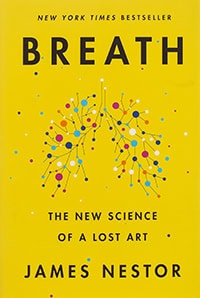
A long time. 5 or 10 years. I don’t know anybody.
Wow, okay. And did you see improvements in metrics like HRV, deep sleep, or anything like that from doing mouth taping?
It’s hard because I didn’t have a WHOOP or anything that I used to track it back when I started, but I’ve had periods of time where I haven’t done it for a little while, and I’ll just kind of fall out of the habit for a little bit. And then when I start, I tend to see little blips of improvement. It’s hard to really say, but I think the science is there enough to show that mouth breathing is unhealthy for various reasons.
Did you read James Nestor’s book? It’s Breath.
The Oxygen Advantage. I forgot if that’s Nester’s. I’ve thumbed through both of them. But you know what? I’ve also done that, and I’ve seen a chain of change from it.
He has a new book.
Keeping my mouth closed when I’m walking. I’ll walk and measure it with my WHOOPS to make sure I stay in zone two or three, a really brisk walk. But then, as soon as you start to get a little bit out of breath, you tend to breathe out of your mouth. And so I’ve tried to do things they talk about in The Oxygen Advantage, where you actually hold your breath a little while you’re out of breath to train your cardiovascular system, and that does make a difference.
Cool. Now, are you familiar with the LiveO2 device?
I’m not. No, what’s that one?
This is kind of an oxygen deprivation and then hyperoxygenation protocol where you put on a mask, a face mask that’s connected to oxygen, and then you actually get, you lower the oxygen level, increase the nitrogen level, and you’re riding on a stationary bike or doing some other kind of exercise that while you are breathing in lower oxygen level air. Then, at the end, they turn up the hyperoxygenation, so you get flooded with a lot more oxygen, and it hyperoxygenates. So cells that don’t typically get much oxygen in your body will become hyperoxygenated.
Now I’m probably butchering the explanation here because I’m not trained on LiveO2, but I did interview one of its executives back in 2016-17. I saw their technology and tried it at a Biohacking Conference, probably the Dave Asprey conference, almost a decade ago. I liked it. I thought, “Wow, this is cool. should have them on my podcast.” I think it’s worth experimenting with. I actually had the executive bring the salesperson who was manning the booth there, because I had a conversation with her. I was just really impressed with her and wowed by her story. She had a very terrible car accident, and she was in a lot of pain, and her body was just not functioning, and she tried pretty much everything.

She tried all sorts of protocols and tech, and one of her last-ditch efforts was LiveO2, which turned her life around. It was such a godsend for her that she ended up applying for a job. When she was finally able to work again, she said, “Well, Cheers.” I don’t know that. It’s changed my life. It saved my life. I might as well work for them if they’ll take me. And so she was the one hooking me up with the device and stuff at the booth, and she was sharing her story while I was talking to her. It’s pretty impressive. I might want to check that out.
I’d love to check that out. Think I’ve heard of and seen things similar to that. It’s awesome. It speaks to that minimum effective dose principle. Suppose you’re limited in what you can do or what time you have, or you’re limited in your mobility for one reason or another, because you have an injury or something like that. In that case, those things can be super valuable, or they can, again, if you’re at an eight out of 10, and you’re like a triathlete that’s really trying to push the envelope, and you want to squeeze that extra couple of miles out of yourself. Those things can be really, really cool.
I saw it on social media or something, but it’s a low-tech version of oxygen deprivation. It’s a mouth guard. You put it in your mouth, and it restricts your breathing. You can turn the dial to restrict your breathing more or less. So every once in a while, a little fidget spinner, when I’m doing some busy work or something, I’ll just play around with it, put it in my mouth. It may make a difference. Maybe it doesn’t. I can run fast for another five minutes when I’m playing basketball on the weekends.
I just looked it up. It’s episode 81. Tom Butler was in the episode about LiVeO2. So, I looked up The Oxygen Advantage. It wasn’t James Nestor. It was Patrick McKeown.
Let’s share a few more, rapid-fire, lightning round-type tips and hacks, biohacks and performance optimizers. Let’s start with some of your favorite books, courses, and masterminds.
My favorite book is Atomic Habits. Because just when there’s a lot of things going on and a lot of chaos around you, like the one thing that you can control, you’ve got to focus on the things that you can control. It provides a great framework for building habits, stacking them, anchoring them, and all that good stuff. That was really, really valuable to me. The Way of the Superior Man was also an awesome one, just on a more personal level. That’s a book every man and every woman should read to better understand and appreciate masculine and feminine.
That’s books. Mastermind?
It’s been a really long time since I’ve done a mastermind.
That’s how we met. We met through Neil Strauss and his secret society that wasn’t so secret; he had a website.
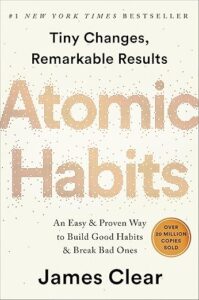
The in-person mastermind stuff, because that’s what it was called, The Society, which was super, super impactful for me. It came at a time when I was doing a lot of soul-searching and needed to do a lot of work on myself to grow in many different ways. Doing that in a group of your peers, in a group of other men.
It was called The Society.
It feels safer, and you can relate to each other. And the best thing about that was, and it’s something that doesn’t exist as much anymore. COVID changed a lot of things, and where we’re going as a society, the experiential nature of it. Cause, especially as intellectual creatures, we overthink the hell out of stuff, and we can always default to our default mode network and our stories that are informed by our traumas and all that kind of stuff.
But if you can get outside of that a little bit and do some sort of exercise or activity. You don’t think about it for a little while, and then you can explore how you showed up in that activity or exercise afterwards, without realizing that’s how you showed up, both internally and externally. That kind of thing is super, super, super valuable. And I encourage all men to seek that out. At the very least, the community and connection components. That’s the thing to say about the centenarians. The biggest component is the community aspect.
Any particular programs? Are there any specific programs that you’ve done more individualized for improving your own discipline and so forth, like 75 Hard, or did you do Tough Mudder or anything like that?
No, I don’t have the time to do a lot of that kind of stuff. And my weekends have become sacred. Just because there’s so much going on and so much work to do during the week. I have a little bit of work on the weekends as well. What my activity of choice has become is playing basketball. I’ve been playing pick-up basketball with the same group of 15 or so guys for almost 10 years now. And we play Saturday morning, super early. It’s from seven to 9 AM. Get up, get your ass out of bed, and get a sweat.
You’re playing hoops with guys in their 30s and 40s. So it’s not crazy, intense. And we’re taking care of each other a little bit as far as injuries and things like that. But that gives me something to look forward to. It gives me something that taps into that competitive nature that I can feed. It gives you small wins here and there and reinforces the camaraderie and community aspects. And so I find myself, that’s valuable in and of itself, but I also find myself training for that which gives me a little bit of a purpose, which is good too.
You have to be able to regulate how you respond to the good and bad things that happen, on a smaller, more specific level, and then on a broader level.
That’s cool. What’s the best thing you’ve learned from those years that you were in the NFL?
Emotional regulation. You could talk about being a part of a team and an organization, a winning team and organization and seeing that firsthand. But personally, developmentally, there’s so much that can happen. And it’s just such a game of inches, and you have to be so locked in for so long, you have to be able to regulate how you’re responding to the good things that happen and the bad things that happen on a smaller level and more specific level, and then even on a broader level.
Even one play to the next. There’s that, but then you zoom out and you get cut by one team that could create another opportunity somewhere else. If you let yourself get all bent out of shape about it, and you’re not able to keep yourself balanced. I even mentioned it earlier in this conversation, but there were no highs or lows. You can’t know, just not to get caught up on that roller coaster too much, which I think subconsciously has served me really well throughout my life and business.
Anger management is part of that emotional regulation. And part of it is also seeing that everything has a silver lining. Everything is ultimately for the good, even though it might look like a total stab or a bad time at the time; it’s actually ultimately for the good. You can get into a place of gratitude for it, then you’re going to end up bringing in a more powerful resolution more quickly.
From a physical perspective, I’ve been thinking about this a lot lately. So you tell me, when you’re low energy, right when you’re tired, does that show up for you as being a little bit more temperamental, a little bit less patient, a little bit less kind, a little bit less emotionally regulated, all those kinds of things? It does, so if that’s the case, then energy is the key to many of the problems that come up in our lives—our partners, our business, our kids, and so on. All this stuff is really relevant. It’s not just for the biohackers, or I’m not listening to that because I’m not into all that, that stuff. But if you think about it, it all comes back around, and it’s all interrelated. And that’s a good way to put a label on the value, paying attention to this kind of stuff, if not for anything else. Do it for Energy so that you have the energy to show up better across all those things.
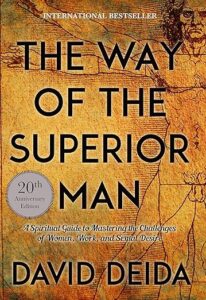
I learned this quote from, I don’t know if it’s his, but from Tony Robbins, and it’s, attention goes, energy flows.
That’s it. So powerful. It’s true.
One little secret hack that I don’t hear people talking about, but it works incredibly well for me to get more energy, is to pray for it. If I want to get into a flow state instead of using Steven Kotler’s 23 flow state triggers, I just pray for it.
Interesting. How does that look? Give me an example.
It’s very simple, and I’ll give you a very tangible, measurable example here. I’ll give you a couple. Our listener probably heard these before, but in the middle of the night, I was using a continuous glucose monitor because I was doing a 42-day metabolic reset diet. And this was part of the protocol. And my blood sugar level dropped into the red zone. And so I got an alarm waking me up about it, and I was so tired. I did not want to get up. So I just asked God to please handle it for me. I didn’t say those exact words, but I asked God for divine assistance on that. And I fell back asleep instantly.
I checked the meter and the readout, and the graph in the morning, and it jumped. As soon as I fell back asleep, I prayed and fell back to sleep, and it jumped back into the black. And I didn’t like taking a drink of anything, like juice or anything. Nothing. I just prayed, slept, and took care. Whatever magic happened inside my body. God handled it for me. So that, that’s, that’s a cool example. Another one is a, this was actually, I was driving back from the biohacking conference. It was in Orlando, and I was driving to Miami with my wife, my son, my mother-in-law, and my sister-in-law. Everybody’s asleep except for me. I’m driving. I can’t listen to music. I can’t listen to podcasts. So I started talking to God in my head. And at that point, earlier in the year, I think, or maybe the previous year, I had done Dave Asprey’s 40 Years of Zen program, which was a week-long neurofeedback program.
It was really awesome. I got some positive memories from my childhood that I hadn’t remembered since then. That was really cool. And I didn’t have an easy childhood. So it was a nice gift to relive those positive memories from my childhood. Well, I just, spontaneously, in this conversation with God, asked for more memories, and I don’t want to spend the kind of money it costs to do a four-week program, so I don’t want to do a week-long program and spend that kind of money again. I got flooded with 10 times the memories that came from the week-long program in Seattle. And it all just, while I was driving, flooded into me. Amazing. So the power of prayer is the best biohack and performance hack there is.
That gives me absolutely. Whatever you want to call it. To whatever god you believe in, whatever higher power.
You can call it whatever you want; it’s all that is, the thing that connects all of us. When you request with intention, humility, and desire, you can bend reality with that divine assistance.
The act of locking in and being fully present in the moment is super powerful.
I believe it. And even the act of locking in and being fully present in that moment is super powerful. Like if that’s what you’re thinking about and that’s what you’re focusing on, then your brain’s not able to be ruminating on what you’re worried about or your past or any other kind of thing. It really anchors you in the present.
That’s actually all you got is the present.
That brings up another often-overlooked component of health that I think is really, really important: stress management. And whether that’s meditation, a stillness practice, or breathwork. I tend to do breathwork, and unless I’m really careful, it tends to upregulate my nervous system a little too much. But when I’m doing something like the 487 breathing or the box breathing techniques, it’s not as much of an issue. Meditation really makes a huge difference for me. And then even just, and even scientifically, right, like cortisol steals from your testosterone. So we have chronically high cortisol; it’s going to cause all sorts of downstream issues. So, 10-15 minutes of meditation a day might be more powerful than taking a drug, supplement, or something like that.
You might be able to get off some prescription meds by doing this.
You just never know. That’s free. Like, “Why not? Why not throw that in there?” We know, we know that it makes a difference, and it’s impossible to expect people to do so. “Hey, have less stress in your life,” like that’s not happening for most people. So it’s not about reducing stress. It’s about managing.
We live in such a chaotic time of great upheaval and change. We’ve not seen more change happen more quickly in human history, so buckle up.
Managing stress. Nobody’s coming to save you, and it ain’t getting better. It’s only getting worse.
I have a positive expectation that everything is ultimately happening for the good, but it is a wild, bumpy ride to get to that time. But the idea of being in control of your own breath and your own kind of nervous response is so critical. Again, get measures, get managed if you’re not tracking this stuff and realizing that your cortisol levels are jacked up or adrenaline, your stress levels with the apps like Oura and the WHOOP, etc., are, if they’re indicating you’re in a stressed state, you need to address it.
Totally, I can tell. There’s a thing in the WHOOP app. I don’t know if it’s in or also where it stretches, but it measures stress while you’re sleeping. There’s a low, medium and high range of stress. And I can during the daytime ones. I haven’t looked at the daytime ones. But the daytime one on the whoop is harder to look at and quantify, because it’s like a graph with up-and-downs.
It does during the day, too; it measures stress levels.
The sleep one tells you how long you were in low stress, how long you were in medium stress, and how long you were in high stress. And typically, most nights it’s all low stress, but there are definitely nights when I’m ruminating on something, or maybe I have a little bit of a cold, or something’s going on, and it’ll be an hour or two in the medium stress zone.
Don’t eat right before you go to bed. That’s a surefire way to screw up your sleep.
That’s another one. That’s another great hack. The earlier I eat, the trickier it gets for me. Because if I try to go too early, I’m starving —right as I’m trying to fall asleep —and I can’t fall asleep. And then it completely backfired because then I got to eat right at bedtime. But that’s another good thing to play around with. Try to stretch that as far as you can. I also saw a sleep specialist talk about a warm bath or warm shower. Because it raises your core body temperature, then cools it down. But the caveat was that it’s most effective when it’s at least two hours before bed. If you try to do it too close to your bedtime, like a lot of people, just take a shower and then get into bed. It can actually work against you a little bit because it gets harder to get into your REM sleep cycle.
This is so good. We’re running out of time, so we’ll have to wrap up. But again, if you could share your website, the discount code for the test kit, and any social platforms you wanna drive people to follow and learn from, that would be great.
vitalityrx.com. You just click get started. GYO20 will be the coupon code for your audience. As for socials, we’re on Instagram at VitalityRx. It’s on Chas Vitality’s TikTok. Chas VitalityRx on TikTok. That’s been a pretty good platform for me. I’m growing pretty quickly on, but I like to try to take pretty complex topics around hormone health and men’s health and put it into terms that everybody can understand and have a little bit of fun with it, use some fun kind of metaphors and comparisons and try not just to be boring old Bill Nye the science guy. Not that he wasn’t awesome.
I remember him. Awesome. Well, thank you so much, Chas. This is great, and congrats on your business, Vitality RX, that you built from the ground up, and on all the people you’re helping improve their lives. So you’re a light in the world. Thank you, Chas.
Thank you, really appreciate it. Thanks for having me. It was great. Appreciate it.
Awesome. And thank you, listener. You, too, are a light in the world. Go out there and make it a great wee,k and do something unexpected and amazing for a loved one. We’ll catch you in the next episode. I’m your host, Stephen Spencer, signing off.
Important Links
Connect with Chas Gessner
Apps and Tools
Books
Businesses/Organizations
People
Previous Get Yourself Optimized Episodes

